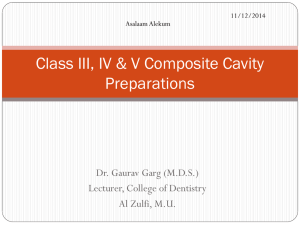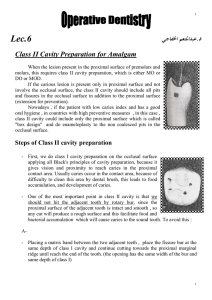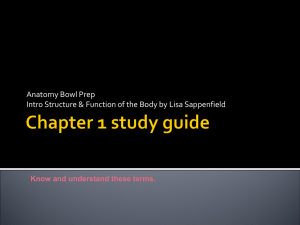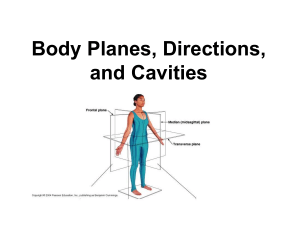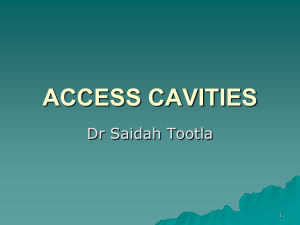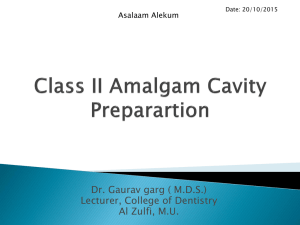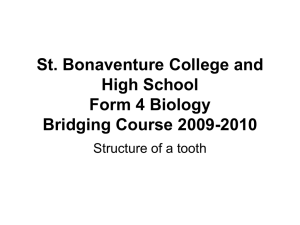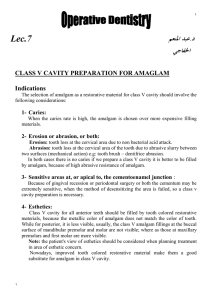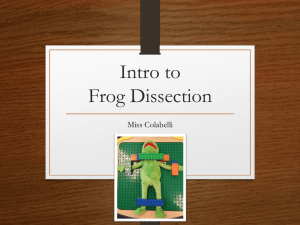Cavity preparation according G.V.Black
advertisement
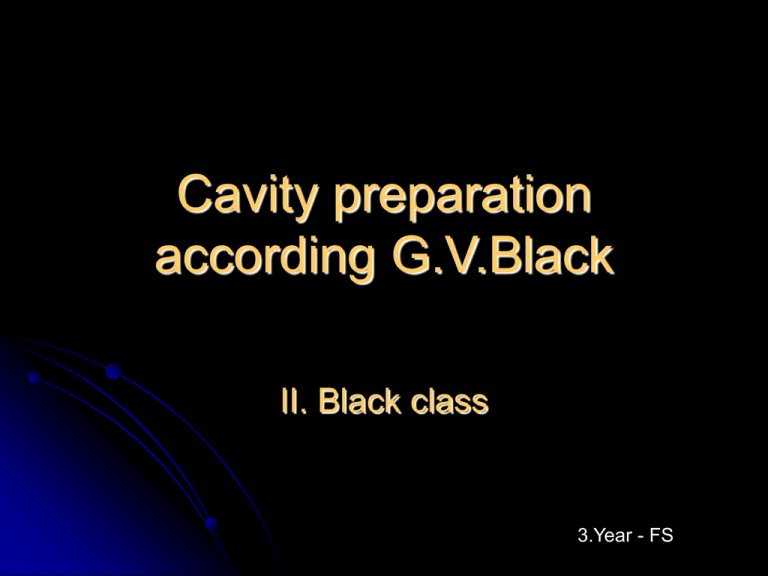
Cavity preparation according G.V.Black II. Black class 3.Year - FS G.V. Black’s Approach to Cavity Preparation 1. Outline form 2. Resistance form 3. Retention form 4. Convenience form 5. Removal of remaining caries 6. Finish enamel walls 7. Clean cavity preparation G.V. Black’s Approach to Cavity Preparation 1. Outline form Based primarily on the location and extent of the caries. Final outline form is not established until the carious dentin and, usually, its overlying enamel has been removed G.V. Black’s Approach to Cavity Preparation 2. Resistance form Resistance to both fracture of the tooth and filling material must be built in so both will be resistant to fracture during function G.V. Black’s Approach to Cavity Preparation 3. Retention form The tooth preparation must be shaped in such a way to retain the filling material, without weakening the remaining tooth structure G.V. Black’s Approach to Cavity Preparation 4. Convenience form Allows adequate observation, accessibility, and ease of operation during the preparation and restoration of the tooth. Only the minimal amount of reduction that will provide the necessary convenience should be done G.V. Black’s Approach to Cavity Preparation 5. Removal of the remaining caries Deeper caries not removed by the initial cavity preparation is now removed. Care must be exercised as the pulp may be in close proximity. G.V. Black’s Approach to Cavity Preparation 6. Finish of enamel walls and margins Remove unsupported enamel, make the margins smooth and continuous to facilitate finishing of the restoration. G.V. Black’s Approach to Cavity Preparation 7. Clean the cavity preparation Rinse away all debris and dry the cavity preparation. Black class II. preparation Black class II. preparation Features of the Class II preparation: open gingival, lingual, buccal contacts; dove tail; reverse “S”; convergent walls; even depth; smooth surfaces; no sharp angles. STANDARD PRINCIPLES Margins 90° (perpendicular) to tangent to carvosurface Proper clearance: 0.25mm – 0.5mm Occlusal, axial and gingival walls in dentin Extension Provide vertical support for occlusal forces Avoid inclined planes Provide vertical support for occlusal forces Convert inclined planes to “steps” Preparation Incorporate the reverse-S curve (all walls approx. 90 degrees to cavosurface) Black II - MOD Preparation Proximal box and rounded axiopulpal angle Preparation Just open” buccal proximal wall Black II - contact point Positive contact Matrix retainer Matrix system A matrix system provides and takes the place of the proximal tooth surface that was removed to restore the proximal contours and contact to their normal shape and function. Posterior Matrix System Universal retainer Also referred to as the Tofflemire retainer. This device holds the matrix band in position. The retainer is positioned most commonly from the buccal surface of the tooth being restored. Components of a Universal Retainer Posterior Matrix System Matrix bands Matrix bands are made of flexible stainless steel and are available in premolar, molar, and universal sizes and thicknesses. The larger circumference of the band is the occlusal edge and is always placed toward the occlusal surface. smaller circumference of the band is the gingival edge and it is always placed toward The the gingiva. Wedges A wedge is either triangular or round and made of wood or plastic. The wedge is inserted into the lingual embrasure to position the matrix band firmly against the gingival margin of the preparation. A wedge correctly positioned. Sectional Matrices A thin polished palodent-type band and a tension ring produce a tight anatomic contact for composite resin materials for class II restorations. Sectional matrices. Thank you for attention!
